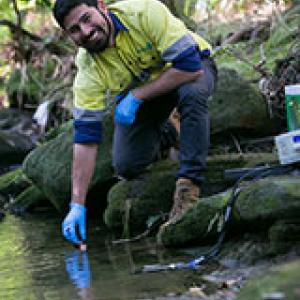
Darren Fernandez
Bachelor of Environmental Biology
Environmental Scientist
Being able to see and help transform these sites into parklands or residential developments is very...
What was your course?
What exactly does your work/job entail?
As a contaminated land consultant, my role is a balance between project management, field work and reporting. In the office, I’m involved with a variety of areas including mining, landfills, acid sulphate soils and contaminated sites. In the field, I can be found supervising a team, delineating contaminants, and walking through the bush to collect soil and water samples for testing– sometimes in the rain and covered in mud!
All of my jobs are carried out in response to appropriate legislation to ensure I’m following best industry practices. I provide simple and pragmatic science-based solutions to obtain a favourable outcome for clients.
What part of your work inspires you the most? Why do you find it interesting?
There are many highlights within my job, but the most prevalent is actually working on a site and witnessing its progress from initiation to completion. I work on highly contaminated sites, including old mine sites, landfills and other industrial sites. Being able to see and help transform these sites into parklands or residential developments is very interesting and gives me a sense of purpose.
As I progress in this field, I am becoming more involved with larger projects that have extra responsibilities. This forces me to stay ahead of the game as I am always challenged and constantly learning more. With the ongoing changes to environmental laws and legislation and the varying methods and technologies that are constantly being introduced, I am excited to see what the future holds.
Do you find the skills you learnt during your degree useful and versatile? If so how?
My studies in environmental science at UTS allowed me to participate in several field trips that focused on things like semi-arid ecology and coral reef ecosystems. I wrote reports on the diverse life found in semi-arid floodplains that generates from a dormant state following rainfall, and on measuring the social interactions of the humbug damselfish on the reef.
While these subjects gave me great laboratory and snorkelling skills, it was the freedom to develop my own project that was most important. This approach encouraged problem solving-skills and an ability to look at the overall picture. These skills are fundamental in an industry that often has multiple solutions for any one issue; by determining a measurable course of action, I am able to achieve the desired outcome.
